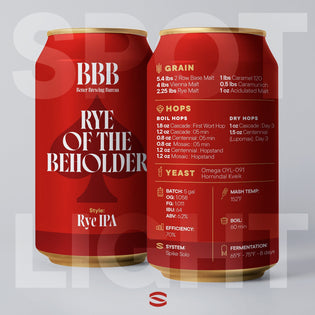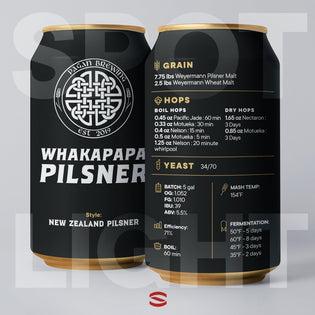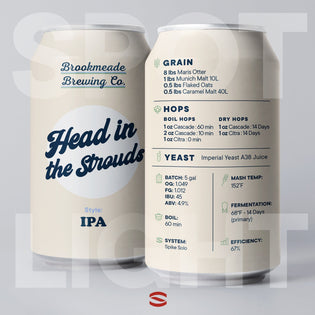The Brewer: Sean Osborne
My name is Sean Osborne, and I'm the head brewer at Mecca Grade Estate Malt. I entered the craft beer scene in Washington when I was stationed there with the Navy. My shipmates were huge beer fans, but I only had a passing interest in it. Eventually, I transferred to Charleston, South Carolina where I really fell in love with the entire craft beer movement there.
I started homebrewing in 2016. My first few attempts at extract brewing were complete trash and I had no idea what I was doing, but I kept at it because I loved the process of brewing. I've been trying to get better ever since.

The Beer: Traditional Bock
As for malt, I researched multiple traditional bock recipes and Munich and Crystal malt is typically used. Metolius is our Munich-style malt and presents a mix of graham cracker and toasted walnut notes. This bock is made with 75% Metolius malt, 25% Opal 44, mashed through a bed of Kentucky bluegrass straw, and lightly battered with Czech Saaz hops. The Opal 44 imparts slightly roasted flavors of toffee and chocolate.
Opal malts are used because they have enough diastatic power to completely self-convert, leading to a dryer, more drinkable beer as opposed to traditional caramel malts that impart residual sweetness. Together these create a beer that is full bodied, highly drinkable, and unique.

The Recipe: Nature of Reality

INGREDIENTS
GRAIN
- 11.25 lbs Mecca Grade Estate Malt Metolius
- 3.75 lbs Mecca Grade Estate Malt Opal 44
- 12.25 oz Weyermann Acid Malt(20L)
HOPS
- Boil hops: 2 oz CZ Saaz -: 60 min
- Boil hops: 1 oz CZ Saaz -: 15 min
- Boil hops: 0.3 oz Perle - 0:15 min
YEAST
- Imperial Yeast Harvest

INSTRUCTIONS
BATCH SIZE: 5.5 gal
OG: 1.069
FG: 1.020
IBU: 21
ABV: 6.5%
EFFICIENCY: 70%
MASH TEMP: 152 ºF
BOIL: 120 min
FERMENTATION: 50ºF - 14 days
SYSTEM: Spike Nano
Pro Tips
- Diastatic Power Diastatic power (DP) is the measurement of a malted grain’s enzymatic content. When grain is malted, enzymes are produced during germination. These enzymes are responsible for converting the grain’s starches into sugar during mashing. Diastatic power is an indicator of the amount of enzymes available to convert those starches into sugar.
- Start fermentation at around 52ºF. After 7-10 days slowly raise temp to 60ºF. Hold for a week then drop back to 50ºF for lagering. Lager for 2+ weeks at 50ºF.
Cheers,
Sean Osborne – Mecca Grade Estate Malt
Spike Summarizes: All Things Bock Beer
What is the history of Bock beer?
Bock beer has a rich history dating back to the 14th century in the German town of Einbeck. The style was later adopted by Munich brewers in the 17th century and adapted to the local brewing style, becoming "Ein Bock" (meaning "billy goat" in German), which eventually got shortened to just "Bock".
The Goat Connection
You might wonder why a goat is often associated with Bock beer. It's all about wordplay! In German, "Ein Bock" also means a billy goat, hence the association.
How does Bock compare to other types of beer?
Compared to other beers, Bock is stronger in flavor and alcohol content. It's a lager, meaning it's brewed with bottom-fermenting yeast, and it has a smooth, clean taste with less fruity flavors than ales.
Bock is distinguished by its high maltiness and low bitterness. Its rich, toasty, and often sweet profile sets it apart from its hop-forward counterparts.
What is the ideal food pairing for Bock beer?
With its rich and hearty character, Bock pairs exceptionally well with robust dishes. Think grilled sausages, roasted pork, or a juicy steak.
But don't forget dessert! Bock's caramel notes also make it an excellent companion for sweets like dark chocolate, caramel desserts, or bread pudding.
Is Bock a Winter beer?
While Bocks can be enjoyed year-round, they are traditionally associated with special occasions and the changing of seasons, especially late winter and early spring. Their higher alcohol content and full-bodied flavor make them perfect for sipping on colder days.
What are the key ingredients in Bock beer?
The key to a Bock's flavor is its heavy reliance on malt. Munich malt, a slightly kilned lager malt, provides the rich, toasty, and sweet flavor profile.
Hops in Bock beer play a supporting role, balancing the sweetness of the malt. Traditional German hop varieties like Hallertau or Tettnanger are often used.
What's the typical ABV of Bock beer?
Bock beers typically have an alcohol by volume (ABV) content ranging from 6.3% to 7.2%, making them stronger than many other beer styles.
Does Bock beer have a fruity flavor?
While Bocks are rich and complex, they're not typically known for fruitiness. Instead, expect a flavor profile dominated by malty sweetness, often with notes of toast, caramel, and sometimes a hint of chocolate.
How is Bock beer brewed?
The Maillard Reaction
As a lager, Bock beer undergoes a process called lagering after initial fermentation. This involves storing the beer at a low temperature for several weeks to months, which helps to create its smooth and clean flavor profile.The rich, toasty flavors come from the Maillard reaction during the boiling of the wort. This is the same reaction that gives browned food its distinctive flavor!
What's the best temperature to serve Bock beer?
Bock beer is best served at a moderate temperature, usually between 45-55°F (7-13°C). This allows the complex flavors and aromas to shine through.
Why is Bock beer so carbonated?
Bock beers typically have a moderate level of carbonation. The carbonation helps to lift the beer's rich and malty sweetness, balancing out its full body and providing a pleasant mouthfeel.
Are all Bock beers the same?
Absolutely not! Bock beer is a style with several variations. Traditional Bock is a dark, malty, lightly hopped beer. Maibock or Helles Bock is lighter in color but still strong and malty. Doppelbock, meaning double Bock, is even stronger and maltier. Lastly, Eisbock is an extra strong beer created by partially freezing a Doppelbock and removing the ice.






